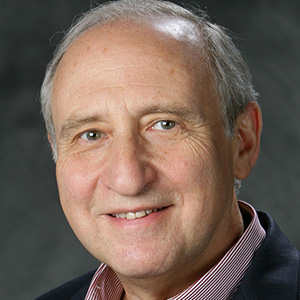Dr. Ben Shneiderman comes from a long line of artists, writers, and photographers. He has applied his own considerable professional creativity to building bridges between disciplines and staying decidedly eclectic in his interests and outlook. He loves finding ‘driving problems’ that need solving, which often means you’ll see him dashing all over campus to talk to folks in other departments. Here he takes a break to talk about influences, rebellions, writing, and being a permanent graduate student.
EXCERPTS FROM THE INTERVIEW
Scientists are smart and capable, but they don’t often choose the right problems. If you work on a real problem that somebody else cares about and that they come to you with, then you have a chance of producing a worthwhile solution that other people will actually put to work.
We’re always thinking about ways in which we empower people to be more effective, more creative, and to make deeper insights. That is our focus. It’s not the computer that does that, it’s the person.
AN INTERVIEW WITH BEN SHNEIDERMAN
Conducted by Tamara Adlin on July 17, 2007 05:42 AM
The famous Dr. Shneiderman muses on mulidisciplinarianism and reminds us that no computer is smarter than a wooden pencil.
Dr. Shneiderman has written some very influential books in our field, including but certainly not limited to Designing the User Interface: Strategies for Effective Human-Computer Interaction, which is now in its fourth edition, and Leonardo’s Leonardo’s Laptop: Human Needs and the New Computing Technologies
.
Thank you for taking time to talk to me this morning.
It was a time when Marshall McLuhan was very influential to me. I did go to meet him and hear his lectures. His notion that the all-electronic world would eliminate the linearity of print and make an “all-at-onceness,” which destroyed fragmentation and therefore promoted interdisciplinary approaches, was a compelling one for me.
I think that’s a wonderful vision, and I think there’s some truth to it. We still struggle with these interdisciplinary visions. McLuhan justified the fact that I didn’t have to choose one major – I could do many different things.
I got more into computer science as a college student since I was working for physicists doing programming on bubble chamber data analysis. That is how, as an undergraduate, I became engaged in the worlds of programming and physics.
That led me down the road towards understanding how to write better, more comprehensible computer programs. Psychology was important to me as well. My early work was on studying programmers before there were any user interfaces beyond programming languages.
He taught me about psychology experiments, and I taught him about computing. That was a very fortuitous collaboration.
I was delighted by something in your bio: Your devotion to photography and your inspiration from an uncle, David Seymour, who was a world-famous photojournalist.
Were there a lot of arts in your family? Was there also some science floating around?
All of my grandparents were killed in the Holocaust, but my parents got out safely. They were journalists in Europe and continued their work in New York, so there was a strong literary tradition around the house. My sister became a professor of English. I had a cousin who was a physics professor and others who were artists. There were eclectic styles in my family, but I didn’t want to choose just one. Since my parents and sister were into the literary world, my rebellion was that I got into computing.
I eventually wound up taking early courses from Richard Hamming; he was out of Bell Laboratories at the time. He taught two courses at City College that basically covered the things he had invented.
He was quite inspirational. The quote at the opening of his book (Numerical Methods for Scientists and Engineers) says, “The purpose of computing is insight, not numbers.”
with my dear friend Charles Kreitzberg. We were 24 year-old kids, but we were trying to make programming a kind of literary language. We thought there were good and bad ways to write programs.
Inspired by the Strunk and White book called the The Elements of Style, Fourth Edition for English literature, we wrote a parallel version for Fortran which talked about choosing good variable names, program layout, good modular design, argument passing, efficient algorithms… It was an early attempt to make a book devoted to the human aspect of programming.
It was not about user interfaces, but how to write Fortran programs that others could comprehend: What was good or bad programming style, good or bad commenting style. Even formatting and indentation were important issues.
Ours was the first of those books. After it there was a cascade of many other books devoted to elements of X style, but we were proud to have been the first.
I’ve always faced those kinds of challenges. I have a fair amount of energy, and seem to be able to do several things in parallel.
Some people don’t believe in that model of multiplicities which seems so central and enriching to me. The chance to work on different things I think enriches them all.
After a few years, I was eager to come back to the East Coast. The University of Maryland was a good opportunity. I came here in 1976 and joined the Department of Information Systems Management, which was close to the Psychology Department. That was an attraction. It was one of the few places where the leadership thought the combination of computing with psychology was a wonderful idea. But that department, because of its eclectic style, lost its political battle and after a few years was eliminated.
I became a member of the Computer Science Department, which was my natural home. I’ve been here ever since.
I have a more eclectic spirit than most, so I am often running across campus to work with colleagues, such as our current effort with Political Science. We’re working on Supreme Court decisions and their citation patterns. We’re also working with people from the Department of English in the Maryland Institute for Technology in the Humanities. And colleagues in Biology, as well as other departments.
For me, it’s great fun to get out and see how we can put our ideas to work for other people. I think one of the great callings of computer science and interface design is that it should be beneficial to someone else. I was influenced by Fred Brooks’ idea of a “driving problem.” This means we have a good problem that we like working on, but somebody else cares about the solution.
We use our skills to build a tool for somebody else. I think that’s a noble quest that has encouraged and accelerated the work we do, and raised its quality dramatically.
, He made a very clear analysis that if you do scientific research and then try to push it into engineering and make products from it, it rarely works. Scientists are smart and capable, but they don’t often choose the right problems. If you work on a real problem that somebody else cares about and that they come to you with, then you have a chance of producing a worthwhile solution that other people will put to work.
I expect that from my students and their semester projects. My goal is that semester projects done in my courses will live on beyond the semester and be useful to someone outside the classroom.
I’ve recently had the great pleasure of reading ten term projects from the 23 students in my graduate information visualization course. They are a terrific bunch of projects, in part I think because this year I insisted that they have an outside user.
I’ve often recommended it, but this time I required an evaluation plan that had domain experts using the interface that the students built.
Just one week after the semester has ended, we’re already submitting two papers to a conference. It’s an unusually strong set of results.
You started out in an information-related department, which lost its political battle and was eliminated, and now 30 years later there are information schools popping up all over the place.
We lay out the territory pretty clearly and make our expectations very apparent. If they want just software engineering to build something that they understand, we send them somewhere else.
In many cross-disciplinary situations, each discipline thinks the other is inferior in some way. Sometimes if our colleagues hear we’re working with English Department, they think we’re doing trivial things. But the English faculty have extremely high demands and expectations for their text analyses that no data mining or computer science has ever touched.
We are gaining the benefit of the challenging questions they are asking. We’re working now with a PhD student in the English department namedTanya Clement, who is studying the patterns of repetition in Gertrude Stein’s book The Making of Americans: Being a History of a Family’s Progress (American Literature Series).
It’s an extremely complex problem. We’re working with the most advanced data mining tools and text analysis, but we have to keep adding to them because these tools are in fact very shallow in terms of providing the kind of understanding that a literary scholar wants to have.
We believe that by bridging two disciplines, we gain as much as we give.
I just met for a working session with a student dealing with disaster response; an effort we call Community Response Grids. Jenny Preece and I wrote a policy essay in the February 16th (2007) issue of AAAS Science Magazine. It produced a great cascade of interest.
We’re trying to think of ways we could build a social networking system on campus involving internet, email, cell phones and other kinds of portable devices, so that people could report emergencies and get information about whether to evacuate or stay in place. They could also have the social networking to help each other as needed.
We’re eager to pursue and build such a Campus Response Grid here at the University of Maryland.
These are substantive, important issues, and we are happy to contribute.
At a certain point you’ve done the parts you want and the works seems attractive, so you get more and more requests for it. For example, for many years we worked on educational technology and electronic classrooms. I get a lot of requests to speak and write about that work, but usually I have to say, “No, that project is past research and now we’re now working on social networking, information visualization and community response grids.”
So I move myself along by remaining forever a dilettante, a graduate student, and a discoverer.


 © 2020 Adlin Inc. All Rights Reserved.
© 2020 Adlin Inc. All Rights Reserved.